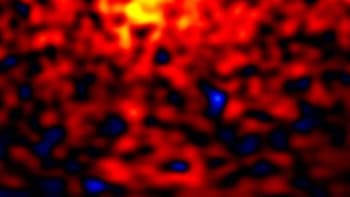
For the first time, astronomers have discovered two distant clouds of gas that seem to be pure relics from the Big Bang. Neither cloud contains any detectable elements forged by stars; instead, each consists only of the light elements that arose in the Big Bang some 14 billion years ago. Furthermore, the relatively high abundance of deuterium seen in one of the clouds agrees with predictions of Big Bang theory.
Just after the Big Bang, nuclear reactions created the three lightest elements – hydrogen, helium, and a tiny bit of lithium. Stars then converted some of this material into the heavy elements such as carbon and oxygen that pepper the cosmos today.
But no-one has ever seen a star or gas cloud made solely of these three Big Bang elements. Instead, all known stars and gas clouds harbour at least some “metals”, the term astronomers use to describe any element, even carbon and oxygen, that is heavier than helium.
Minutes after the Big Bang
Now, Michele Fumagalli and Xavier Prochaska of the University of California, Santa Cruz and John O’Meara of Saint Michael’s College in Vermont, have found two pristine gas clouds. “Their chemical composition is unusual,” says Fumagalli. “This gas is of primordial composition, as it was produced during the first few minutes after the Big Bang.”
One gas cloud resides in the constellation Leo, the other in Ursa Major. The Leo cloud has a redshift – a measure of its distance – of 3.10, which means it is 11.6 billion light-years from Earth. The Ursa Major cloud is slightly farther away, with a redshift of 3.41 and at a distance of 11.9 billion light-years. We therefore see both clouds as they were about two billion years after the Big Bang.
The clouds are far too faint to observe directly. Fumagalli and colleagues discovered them only because the clouds happen to lie in front of even more distant quasars, which are luminous galaxies that were much more common long ago. Atoms in the gas clouds absorb some of the light from the background quasars, and the wavelengths at which absorption is evident reveals important information about the composition of the clouds.
Hydrogen only
Despite using the mammoth Keck I telescope atop Mauna Kea in Hawaii, the astronomers failed to find any element except hydrogen in the two clouds. While the researchers also expect helium and lithium to be present, their technique is not sensitive to those elements. However, if oxygen, carbon or silicon were present, it should have been easy to spot. From this, the researchers deduce that the metal-to-hydrogen ratio (or metallicity) in the Leo cloud is less than 1/6000th of that of the Sun and in the Ursa Major cloud is less than 1/16,000th of the Sun’s metallicity.
In comparison, ancient stars in the Milky Way’s most primitive population – the stellar halo – typically have metallicities that are 1/50th of that of the Sun. The most metal-poor halo star known has a metallicity 1/22,000th that of the Sun, which is similar to the upper limit of the two gas clouds.
“It’s a very interesting discovery,” says Nick Gnedin, an astronomer at Fermilab in the US, who is unaffiliated with the discovery team. Gnedin says it has been very difficult to understand why all other gas clouds – even those at greater distances – contain metals. These newfound exceptions should help astronomers understand why all other gas clouds contain metals, he says.
Agrees with Big Bang predictions
In addition to ordinary hydrogen, Fumagalli and colleagues detected the hydrogen isotope deuterium in the Ursa Major cloud. Physicists believe that the Big Bang produced deuterium but that stars then destroyed it – so the universe once had more deuterium than it does today.
The high deuterium-to-hydrogen ratio in the gas matches Big Bang predictions. “The fact that we see deuterium that is comparable to what is expected from theory is giving us more confidence that this gas is actually primordial in its composition,” says Fumagalli.
“Nice connection”
Rob Simcoe of the Massachusetts Institute of Technology says that the two clouds show that pockets of the universe remained free of stars and their ejecta for some two billion years after the Big Bang. “This is a nice connection between work that is being done on the early universe using these gas clouds and work that is being done in our backyard, in the stellar halo of the Milky Way, where people have discovered stars that have comparably low chemical abundances,” he says.
Each gas cloud has only about a millionth of the Milky Way’s mass. Simcoe suspects that each will eventually fall onto a galaxy and form stars. If one of those galaxies now has astronomers, they may be peering at the nascent Milky Way and seeing primitive gas clouds that spawned stars in our own galaxy’s stellar halo.
The observations are reported in Science.



